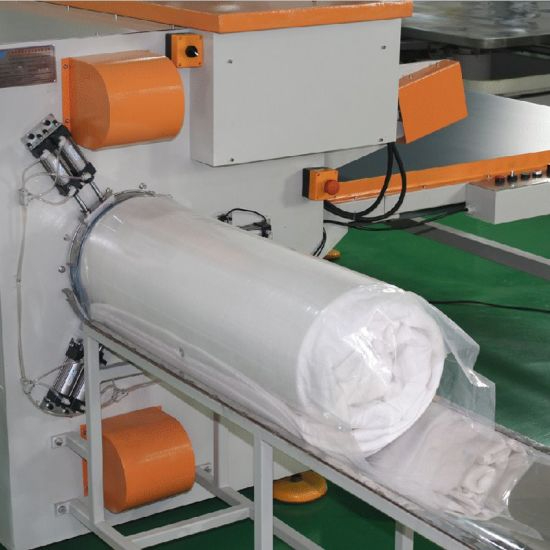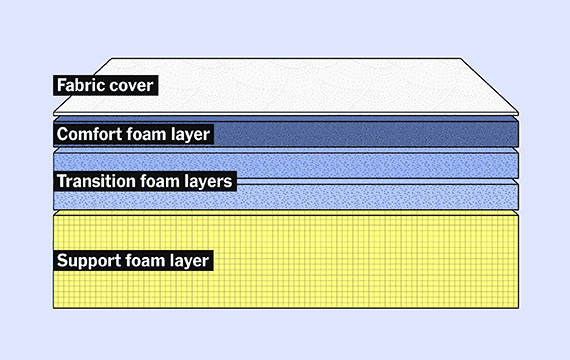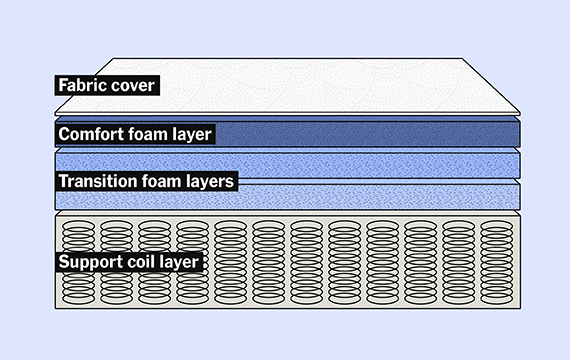Are All Online Mattress Companies Selling The Same Mattress?
Are you scrolling through endless web sites, trying to shop for a mattress? It can be really confusing with over 200 online retailers. On this page, I’m going to teach you how to buy a mattress.
I will also give you links on this site so you can quickly learn everything you need to know about finding the perfect mattress for you.
In 2007 I was one of just 8 online mattress companies selling a mattress which was made from natural latex, rolled, and compressed, and shipped directly to your home.
As one of the original “bed in a box” pioneers, the market was wide open and I was figuring out how it all worked.
The hard part was partnering with a third party fabricator who could build my mattress to the exact specifications I had designed and who possessed a roll pack machine, a rare commodity in 2007.
I found the company I was looking for to make my line of pure, all natural latex mattresses just outside of Boston.
Jeffco Fibres, a family business for over two generations built, rolled, and shipped tens of thousands of my mattresses. There was virtually no competition and my team and I couldn’t believe we had practically stumbled into the most amazing business journey of our lives.
It didn’t take very long before other third party fabricators, looking for opportunity, to partner up with budding entrepreneurs who could build a slick web site and invent a foam mattress, or at least hire a mattress designer to build one for you, to buy a fleet of roll pack machines.
Check out this video to see a demonstration of a typical machine used to compress and roll mattresses, the most commonly used technology to ship mattresses sold online.
Roll packing and compression machines were now being made by multiple companies all over the world, and by 2005, there were about 30 new online mattress e-tailers were selling rolled mattresses online that would arrive at your door, could be quickly unfurled and plopped onto your bed base, all in the span of moments.

The Online Mattress Industry Has Exploded
Fast forward to today, and, as the editor and founder of the only online mattress review site actually run by a mattress industry expert, we’ve counted 215 online mattress companies.
But the big question to most consumers has quickly become “are you guys all basically selling the same thing?”. And the answer is, mostly, yes.
Part of the process about learning how to buy a mattress involves understanding that, for the most part, most mattresses are very similar in design.
Mattress shopping has changed dramatically in the last few years, with trips on Saturday to big box brick and mortar mattress stores almost a thing of the past.
As these retail stores quickly become abandoned, almost everyone is buying their mattresses online.
After all, and I can vouch for this, unboxing a compressed mattress and watching it expand into a king sized bed is pretty cool, and mind boggling, too.
Ordering is easy and with just a few clicks you can choose a new mattress and you’ll have it at your front door in about a week or so. But here’s the thing: more and more consumers are starting to find that choosing a mattress while shopping online and then getting to the buy button without being distracted by the other 14 tabs you still have open raises the big question.
Which one is the right one, and why do they all start looking the same after just a few minutes? How do you buy a mattress that is comfortable, supportive, and will last?
As someone who designed and marketed over 50 different “bed in a box” mattresses, I can tell you- almost all of them are virtually identical. In fact, our site only recommends about 40 mattresses found online, and we actually narrow that down to about a dozen real favorites that we consider excellent choices- out of that 215 mattress options sold on a dizzying number of sites.

Typical Mattress Configuration
There are basically two formats for mattress construction if you are choosing from vendors online.
Most are all foam mattresses, and the architecture is pretty much the same, with foam layers at the bottom being firmer, and gradually getting softer up top.
Layers like memory foam, gel foam, and even latex foam are situated near the body contact area so that you can feel the benefits of these ingredients.

Hybrid Mattress Options May Provide Better Support
When combining foam layers with pocketed coil systems, usually referred to as “innersprings”, a mattress can be more supportive, have more spring back, and be better for back issues.
A hybrid mattress is usually the preferred design for mattresses created for larger people, some couples, and disabled people.
Transferring in and out of a hybrid mattress is often easier because of better edge support.
Here is my curated list of online retailers that sell hybrid mattress options.
One of the most important things to remember is that the biggest brands we see out there, the so-called “mattress industry disruptors” who say they invented the bed in a box concept (we were doing it long before today’s company’s creators finished high school) have yet to actually make a profit.
You might be buying a mattress from a company whose 10 or 20 year warranty- might not be worth anything at all. Learning how to buy a mattress involves understanding warranties and how they work.
When spinning up on how to buy a mattress online, your first big stumbling block is going to be one of many so called “mattress review sites” that are owned by the very mattress companies whose very brand they are pitching.
Note: my site is one of the very few review platforms not owned by these mattress companies, and we are the only mattress review site owned by someone who actually worked in the industry.
It’s smart to sort out the reviews, but make sure you rely on certified reviews such as those found on Google, or a third party resource like TrustPilot, Yelp, or Consumer Reports. The other problem with review sites in general is that they rate and review every-single-mattress out there which makes it all the more confusing, with way too many choices.
Our site, for example, only recommends about 40 mattress brands. If you don’t see a brand on our site, it’s because they simply didn’t make the cut.
Basically, the concept for building and designing a comfortable mattress is pretty simple and doesn’t really allow for huge diversity, which is why most of the mattresses you are buying look pretty much the same.
“The products that you’re buying — there are many similarities and only some minor differences,” said Seth Basham, an analyst at Wedbush Securities who researches the bedding business.
He observes that the base layer, the bottom piece, of most mattresses sold online by dozens of companies, often use exactly the same foam. The ingredient likely is sourced from one of about 2-3 companies in the world. “The different layers — what goes on top of what, can differ. But the big difference is how they’re being sold and marketed.”
Mr. Basham is precisely correct. In fact, when we were in the manufacturing business ourselves, we routinely designed lines for many brick and mortar stores as well as our own stores, and used the same bottom piece of support foam, and then interchanged the top 2-3 layers with different densities of memory foam, latex, or other kinds of foam to create different models slightly different sensations.
This wasn’t really deceptive as each model felt differently and had different appeal to various individuals or couples. And by using more attractive or sophisticated outer fabric coverings, you could create a higher ticket item, and add various features, such as a pillow top, a layer of sumptuous wool, or other materials. This added variety and diversity to your line.
Step back and imagine how many different variations you could create using just 3-5 different kinds of foam with different coverings on the outside and market each of them differently on 215 web sites that have their own pitch, design scheme, models, slogans, and spokespeople.
For the average consumer, it’s a confusing and anxiety inducing nightmare to try to choose the perfect mattress. Online sales are increasing rapidly and now account for about 15% of the $18 billion mattress industry, though only the top 10 bed in a box companies really make a significant dent, according to Mr. Basham.
The big name brands of yesterday, mattress giants like Tempur- Sealy and Serta-Simmons should be nervous, claims Peter Keith, an analyst at a think tank called Piper-Jaffray.
Sales from these powerhouse mattress manufacturers have taken a nose dive over the past two years, as much as 10% of their former market share. A survey by the International Sleep Products Association reported that an astonishing 45% of mattresses purchased in last year were online, up from 35% for purchases just two years earlier.
So why have the larger online bed in a box companies made money? Well, first of all, many of them have. The list included in our top ten mattresses in our Trusted Dealer program have made money, but the big players are still losing cash.
It might be wise to consider investing in a mattress that is made by a profitable company who’ll be there if you should have an unlikely issue down the road, or perhaps if you want to order another mattress.
As we discusses earlier, almost anyone can prop up a site on the internet and create a mattress, find a company that will make it for you, compress and roll it, and ship it out. But, profitability is hard to come by because it is so easy.
There are so many companies out there competing for a search result on Google, that most get lost in the fog of confusion. When learning how to buy a mattress, it’s important to let an expert take the lead to get rid of the deadwood first.
Having hundreds of online mattress companies compete aggressively online definitely makes the market competitive, according to Basham. “Barriers to entry are low, but barriers to profitability are high,” he said. “It doesn’t take that much energy or money to design a mattress, a marketing campaign, put up a website, and have one of these big companies like Carpenter do the customer fulfillment for you,” he said, referring to one of the key mattress manufacturing companies and third party fabricators.
Almost all of the larger bed-in-a-box online retailers outsource their manufacturing, according to industry insiders. “None of these guys, with a few rare exceptions, make their own mattresses,” he said. “They’re literally calling around to producers saying, ‘we need a finished product and here’s what we think it should look like.’ Sometimes, they don’t even know what they want it to look like.”
There are a few companies that make their own mattresses, but it’s rare. The company we recommend as our top rated mattress, called Puffy, has their own factory and fulfillment, and other companies such as Brentwood Home, Brooklyn Bedding and Purple, also build and ship their own products.
Many of the bigger bed-in-a-boxes do the research and development of the mattresses themselves, and create their own specialized secret recipes and patent them, offering a slightly different feel. Some of these companies include Tuft & Needle and Leesa, but are they really that different?
Also, consider that most of the online bed in a box companies are outsourcing to just four major third party fabricators, according to Dan Schecter, senior vice president of sales and marketing at Carpenter. He said his company makes mattresses for 40% of the mattress industry at 60 factories throughout the country. That includes including roughly 14 bed-in-a-box brands, along with all the traditional players like Tempur Sealy.
“The customer comes to us … they say they want a mattress that does these things against the body, and they would like to have these features and advantages as part of their marketing story. We then create the mattresses that dovetail with what their vision is,” he said.
One online retailer called Layla, CEO Akrum Sheikh said companies that manufacture their own products are “at a disadvantage as they may find themselves being limited to the use of their own technologies and capabilities.” We think this is probably not true, considering that the techniques and the equipment used in the factories where companies build their own beds can source proprietary and secretive ingredients from a rapidly growing boutique components industry.
Unique blends of gel foam and latex foam, memory foam, natural latex, plant based foams using herbs and vegetables, specialized innerspring or micro-coil layers, and other really cutting edge mattress ingredients are helping fuel diversity and are adding something different to the ubiquitous big block of foam with a pretty exterior.
“For a while there were a lot of similarities, but you’re starting to see the bigger companies diversifying their offerings,” another insider said. For example, some brands are now selling luxury and cheaper versions, or hybrid models that include both foam and springs.
confusion and too many choices
All that being said, it might be that consumers need to rely on sites like this one to help them narrow down the field. Too many choices and cups and ball trickery, known all too well to be a blight in the mattress industry, is overwhelming to customers, even those ready to pull the trigger.
“It’s the amount of information. There’s just too much,” Basham said. “If you go online, not only most of the mattresses for sale look alike, but they’re all talking about their different products. If I tell you that my mattress is special because it’s infused with copper gel, does it mean anything to you?”
Layla, Sleep Science and Propel by Brooklyn Bedding all sell copper-infused mattresses. DreamCloud, Leesa, and even Walmart-owned Allswell are just some of the brands offering these so-called hybrid mattresses.
On the Mattress Buyer Guide, we clearly distinguish between categories to help differentiate different mattress types along with brands as well. My Trusted Dealer Page clearly breaks down your options by first recommending only a handful of brands, dividing them into mattress type, and then offering simple, brief, and concise overviews that suggest why you should buy a particular model from a particular site.
Brand Copy Cats Make Shopping Even More Confusing When Learning How To Buy A Mattress
And the sameness between companies applies to their marketing and brand identities, too, according to Armin Vit, co-founder of graphic design firm UnderConsideration. He sees resemblances in the companies’ colors, fonts and advertising messages. “You can see a similar approach,” he said. “In my mind, Casper was the first, so I think they sort of set the tone. They did well, and others followed.”
Casper, which was founded in 2014, was among the first bed-in-a-box company to gain widespread recognition, though our company, Habitat Furnishings, was shipping out bed in a box mattresses ten years earlier. Their logo, which is navy blue with a sans-serif font, is eerily similar to Leesa’s, launched in 2015, Nectar Mattress, which was founded in 2016, and Purple’s, also formed in 2016.
Vit said that the likeness of the logos and marketing could be intentional. “The goal is for something to look familiar,” he said, because there’s a chance consumers will mix up someone’s mattress recommendation with another company’s.
“It’s not ideal, it’s not the most creative or authentic thing to do, but it’s kind of like getting sales and getting customers with confusion in the marketplace.” Even if you pick up the breadcrumbs left over, there is so much traffic out there that it’s a win for the underdog brands.
The company messaging isn’t much better, for many of the larger brands, either. For example, Casper says its memory foam mattresses is for “those who want a ‘just right’ feel whether you sleep on your back, side or stomach,” while the Nectar’s mattress firmness is also “just right” and provides “optimal comfort and support — whether you sleep on your front, back, or side.”
Vit said, “There’s a certain comfort in doing what the successful company’s doing. Someone takes the lead and everyone else says, ‘Hey, that seems good, let’s go there.’ It’s not exciting, but it’s sort of smart.”
In the end, the best way to wade through all of the confusion, learn how to buy a mattress, and make a choice you can live with is to rely on expert opinion. Do you want to take the advice of a twenty something guy in khaki shorts bouncing up and down on a mattress in a video, or do you want to choose from a curated list chosen by an industry CEO who spent 25 years designing mattresses for the bed in the box industry?
Learning how to buy a mattress isn’t easy, but I hope this page gave you a little insight into the industry!